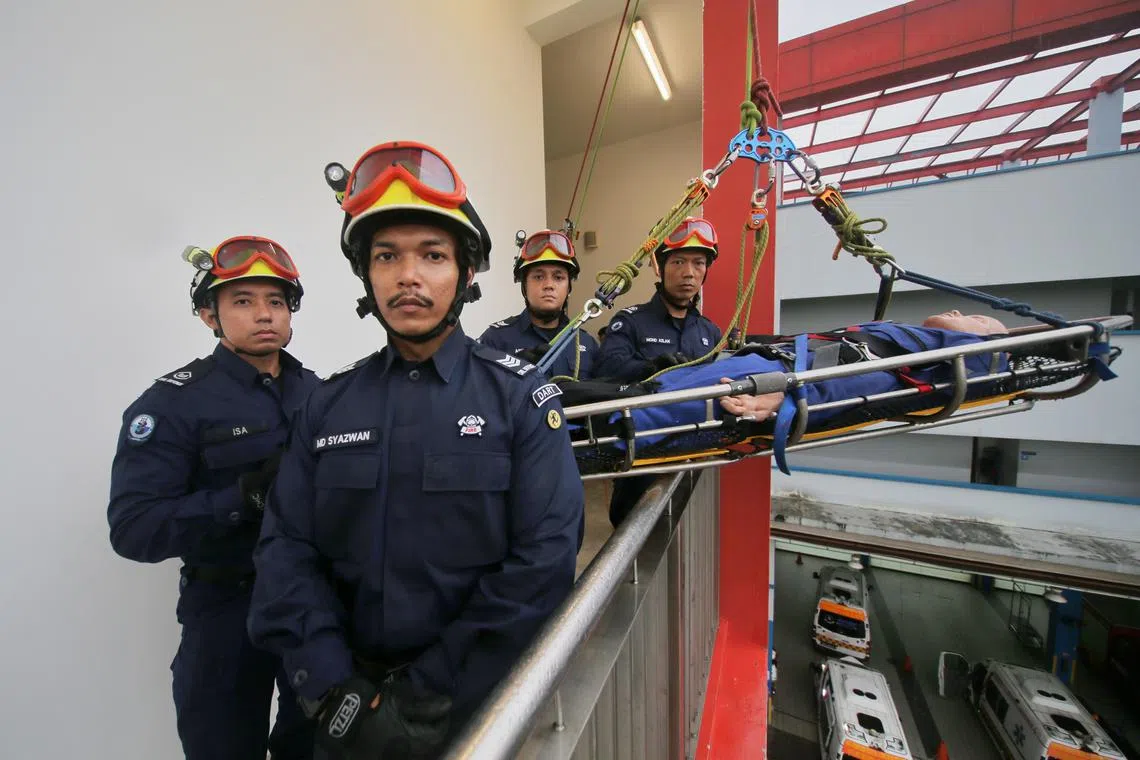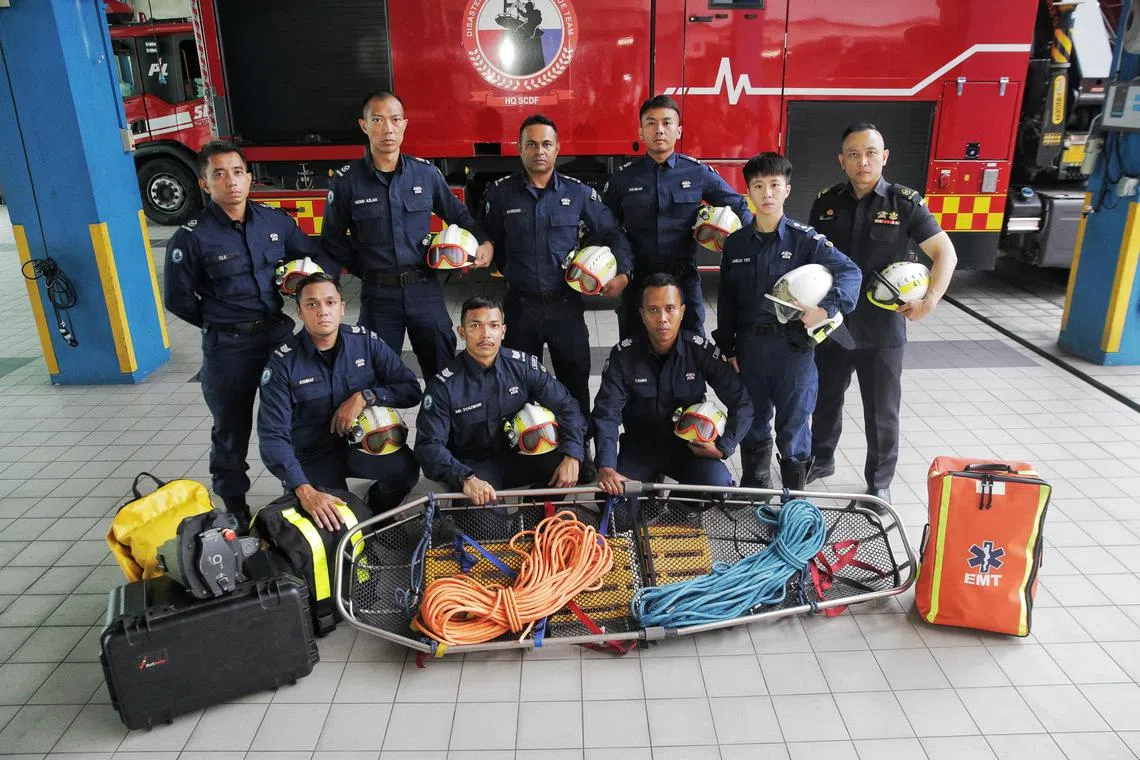‘I had to keep him calm and awake’: SCDF officer on rescuing possible stroke victim from 40m Tuas crane
Sign up now: Get ST's newsletters delivered to your inbox

(From left) SCDF Dart specialists WO1 Isa Endin, SGT3 Mohammad Syazwan, SGT3 Ana Shaik Ashraf and their section commander WO1 Mohd Azlan.
ST PHOTO: WALLACE WOON
Follow topic:
SINGAPORE - The situation: A man is possibly suffering from a stroke, and it is imperative that he be taken to the hospital as soon as possible.
But he is unable to come down from the top of the 40m tower crane on which he is working.
To compound matters, rescuers must work within a space that is smaller than a table-tennis table atop the crane, about 13 storeys high, to get the victim and themselves down safely.
Despite these difficulties, about 20 responders from the Singapore Civil Defence Force (SCDF) and its Disaster Assistance and Rescue Team (Dart) managed to pull off such an operation in 90 minutes on Sunday,
Responding to a call at 2.25pm that day, SCDF officers from the Tuas View Fire Station were the first on scene, where Rota commander Amelia Yeo and emergency medical technician Maswandy Ali climbed up the crane to check on the victim.
To do so, Warrant Officer 1 (WO1) Maswandy had to leave most of his equipment on the ground, taking with him only a pouch containing a stethoscope, a thermometer, a blood oxygen meter and a blood pressure monitor.

WO1 Maswandy had opted to bring only a pouch containing a stethoscope, a blood pressure monitor, a blood oxygen meter and a thermometer up the 40m-high tower crane.
ST PHOTO: WALLACE WOON
Lieutenant Yeo said: “We climbed up so that we could better assess the status of the crane operator and to alert the Dart team of the space constraints ahead of their arrival, so they could deploy their manpower and resources more efficiently.”
WO1 Maswandy, who is also a trained firefighter, said the operator was sitting on the floor of the cabin and his body had slumped over to the right side.
He said: “The operator appeared to look dazed so I checked his condition and performed a test to check for signs of a stroke.
“The right side of his face was drooping and he could not raise his right arm. He was awake but could only answer to questions with yes and no.”
They relayed the information to the Dart team, which then formulated a rescue plan while en route from the Jurong Fire Station, where they were based.
A team of Dart specialists – Sergeant 3 (SGT3) Mohammad Syazwan, SGT3 Ana Shaik Ashraf, WO1 Isa Endin and WO1 Mohd Azlan – then made their way up the crane’s cat ladder, after Lt Yeo and WO1 Maswandy had descended.
Up at the top, the quartet had a space of only about 1.8m by 1.2m to work in while setting up the rescue.

(Front row, from left) SGT3 Ana Shaik Ashraf, SGT3 Mohamad Syazwan, SSG Muhammad Tamimi and (back row, from left) WO1 Isa Endin, WO1 Mohd Azlan, Lt Mohamad Salih Shaik Dawood, WO1 Zulhelmi Sa’adon, Lt Amelia Yeo and WO1 Maswandy, and some of the equipment used during the rescue operation at the project site of the Tuas Water Reclamation Plant on Sunday.
ST PHOTO: WALLACE WOON
SGT3 Ashraf, who had been tasked with climbing above the crane’s cabin onto the main boom and setting up the rigging system along with WO1 Isa, said that he and the rest of the team had to each carry at least 10kg of equipment while climbing up the crane’s ladder.
“The gear we needed to bring up included a 100m-long rope as well as multiple pulleys and carabiners attached onto our harnesses,” said SGT3 Ashraf. “As for the stretcher, we could only hoist it up once we had set up the anchor on the main boom, away from the platform outside the crane’s cabin.”
WO1 Azlan added: “Thankfully, that day, the weather was in our favour. It was cloudy and there was no rain. There was just a light breeze too, no strong winds that might have made our task more challenging.”
With the rigging done and the victim secured in the stretcher, SGT3 Syazwan then accompanied the victim as the latter was lowered down by rope.
During the 10-minute descent, the 13-year SCDF veteran asked the victim questions, such as whether he had eaten or was thirsty, to keep him calm.
SGT3 Syazwan said: “I had to keep him calm and awake, so I had to engage him in small talk and conversation. We have done this many times in our training and even though we use a training dummy, we are taught to make a habit of talking to the ‘victim’.
“Apart from communicating with my team members and ensuring that the lowering was done smoothly, I also had to constantly assure the victim that things were going smoothly, as it could be a problem if he started panicking.”
An SCDF spokesman said that it has performed 14 similar height-rescue operations since 2019 from tower cranes, boom lifts and gondolas.
In 2021, a crane worker who had injured his leg
Dart commander Lok Wee Keong, who was on site at Sunday’s rescue operation, said regular training for rescue specialists would simulate as many scenarios as possible, such as rescuing a person from a crane or from a cable car.
Lieutenant Colonel Lok said: “To expose our Dart personnel to as many scenarios as possible, we’ve also arranged with the operators of some of the various attractions and landmarks so that they have a feel for the environment or some of the challenges they might face in those situations.”


